ECO mode CADILLAC DEVILLE 2005 8.G User Guide
[x] Cancel search | Manufacturer: CADILLAC, Model Year: 2005, Model line: DEVILLE, Model: CADILLAC DEVILLE 2005 8.GPages: 420, PDF Size: 2.63 MB
Page 203 of 420
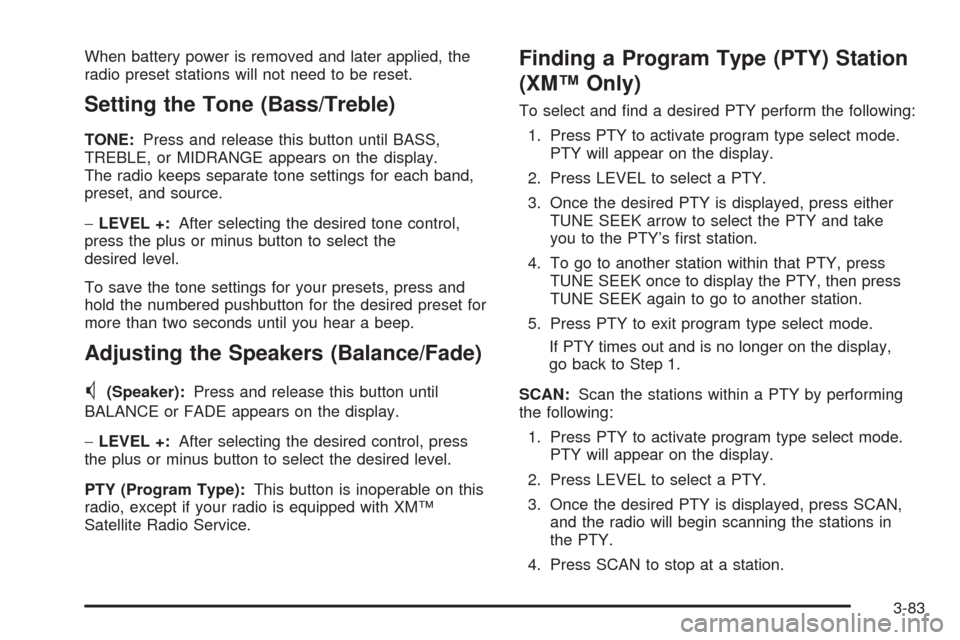
When battery power is removed and later applied, the
radio preset stations will not need to be reset.
Setting the Tone (Bass/Treble)
TONE:Press and release this button until BASS,
TREBLE, or MIDRANGE appears on the display.
The radio keeps separate tone settings for each band,
preset, and source.
−LEVEL +:After selecting the desired tone control,
press the plus or minus button to select the
desired level.
To save the tone settings for your presets, press and
hold the numbered pushbutton for the desired preset for
more than two seconds until you hear a beep.
Adjusting the Speakers (Balance/Fade)
M
(Speaker):Press and release this button until
BALANCE or FADE appears on the display.
−LEVEL +:After selecting the desired control, press
the plus or minus button to select the desired level.
PTY (Program Type):This button is inoperable on this
radio, except if your radio is equipped with XM™
Satellite Radio Service.
Finding a Program Type (PTY) Station
(XM™ Only)
To select and �nd a desired PTY perform the following:
1. Press PTY to activate program type select mode.
PTY will appear on the display.
2. Press LEVEL to select a PTY.
3. Once the desired PTY is displayed, press either
TUNE SEEK arrow to select the PTY and take
you to the PTY’s �rst station.
4. To go to another station within that PTY, press
TUNE SEEK once to display the PTY, then press
TUNE SEEK again to go to another station.
5. Press PTY to exit program type select mode.
If PTY times out and is no longer on the display,
go back to Step 1.
SCAN:Scan the stations within a PTY by performing
the following:
1. Press PTY to activate program type select mode.
PTY will appear on the display.
2. Press LEVEL to select a PTY.
3. Once the desired PTY is displayed, press SCAN,
and the radio will begin scanning the stations in
the PTY.
4. Press SCAN to stop at a station.
3-83
Page 210 of 420
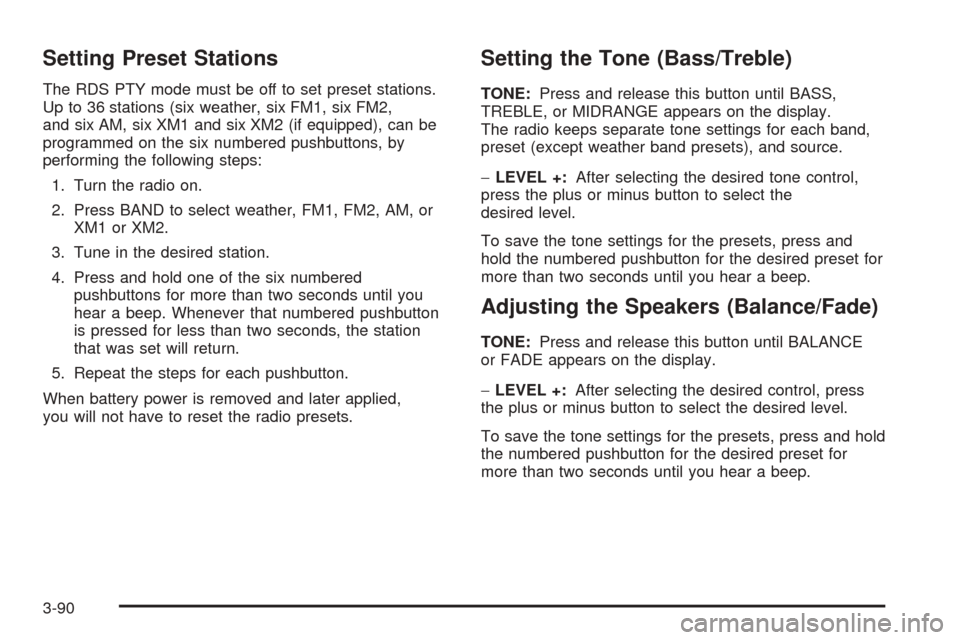
Setting Preset Stations
The RDS PTY mode must be off to set preset stations.
Up to 36 stations (six weather, six FM1, six FM2,
and six AM, six XM1 and six XM2 (if equipped), can be
programmed on the six numbered pushbuttons, by
performing the following steps:
1. Turn the radio on.
2. Press BAND to select weather, FM1, FM2, AM, or
XM1 or XM2.
3. Tune in the desired station.
4. Press and hold one of the six numbered
pushbuttons for more than two seconds until you
hear a beep. Whenever that numbered pushbutton
is pressed for less than two seconds, the station
that was set will return.
5. Repeat the steps for each pushbutton.
When battery power is removed and later applied,
you will not have to reset the radio presets.
Setting the Tone (Bass/Treble)
TONE:Press and release this button until BASS,
TREBLE, or MIDRANGE appears on the display.
The radio keeps separate tone settings for each band,
preset (except weather band presets), and source.
−LEVEL +:After selecting the desired tone control,
press the plus or minus button to select the
desired level.
To save the tone settings for the presets, press and
hold the numbered pushbutton for the desired preset for
more than two seconds until you hear a beep.
Adjusting the Speakers (Balance/Fade)
TONE:Press and release this button until BALANCE
or FADE appears on the display.
−LEVEL +:After selecting the desired control, press
the plus or minus button to select the desired level.
To save the tone settings for the presets, press and hold
the numbered pushbutton for the desired preset for
more than two seconds until you hear a beep.
3-90
Page 212 of 420
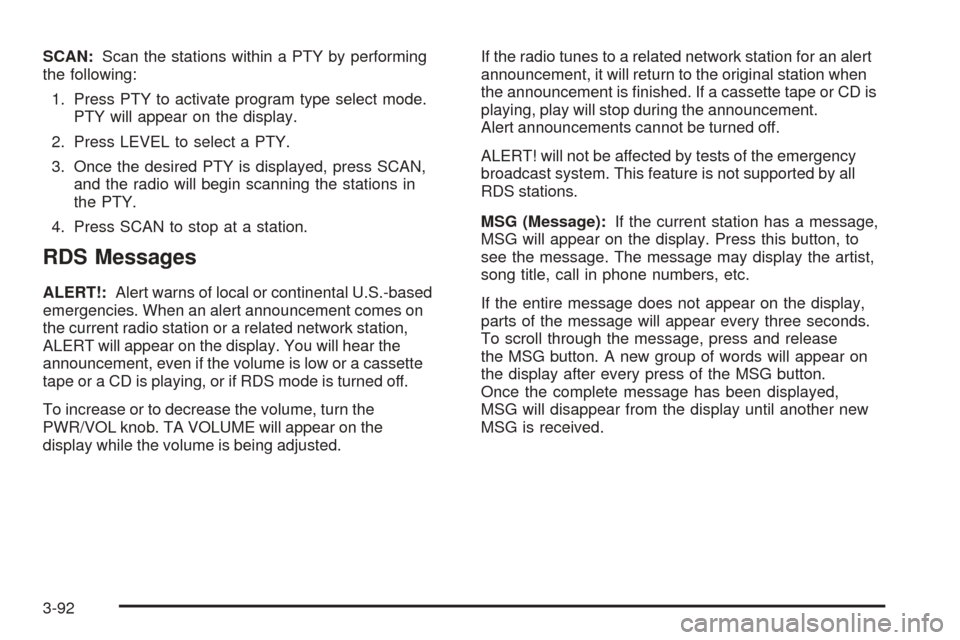
SCAN:Scan the stations within a PTY by performing
the following:
1. Press PTY to activate program type select mode.
PTY will appear on the display.
2. Press LEVEL to select a PTY.
3. Once the desired PTY is displayed, press SCAN,
and the radio will begin scanning the stations in
the PTY.
4. Press SCAN to stop at a station.
RDS Messages
ALERT!:Alert warns of local or continental U.S.-based
emergencies. When an alert announcement comes on
the current radio station or a related network station,
ALERT will appear on the display. You will hear the
announcement, even if the volume is low or a cassette
tape or a CD is playing, or if RDS mode is turned off.
To increase or to decrease the volume, turn the
PWR/VOL knob. TA VOLUME will appear on the
display while the volume is being adjusted.If the radio tunes to a related network station for an alert
announcement, it will return to the original station when
the announcement is �nished. If a cassette tape or CD is
playing, play will stop during the announcement.
Alert announcements cannot be turned off.
ALERT! will not be affected by tests of the emergency
broadcast system. This feature is not supported by all
RDS stations.
MSG (Message):If the current station has a message,
MSG will appear on the display. Press this button, to
see the message. The message may display the artist,
song title, call in phone numbers, etc.
If the entire message does not appear on the display,
parts of the message will appear every three seconds.
To scroll through the message, press and release
the MSG button. A new group of words will appear on
the display after every press of the MSG button.
Once the complete message has been displayed,
MSG will disappear from the display until another new
MSG is received.
3-92
Page 213 of 420
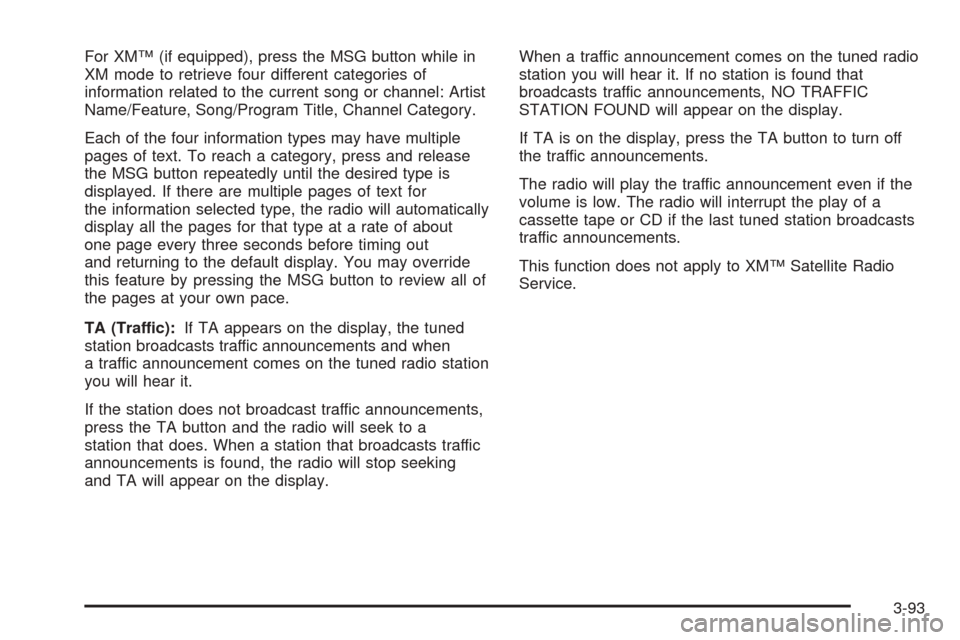
For XM™ (if equipped), press the MSG button while in
XM mode to retrieve four different categories of
information related to the current song or channel: Artist
Name/Feature, Song/Program Title, Channel Category.
Each of the four information types may have multiple
pages of text. To reach a category, press and release
the MSG button repeatedly until the desired type is
displayed. If there are multiple pages of text for
the information selected type, the radio will automatically
display all the pages for that type at a rate of about
one page every three seconds before timing out
and returning to the default display. You may override
this feature by pressing the MSG button to review all of
the pages at your own pace.
TA (Traffic):If TA appears on the display, the tuned
station broadcasts traffic announcements and when
a traffic announcement comes on the tuned radio station
you will hear it.
If the station does not broadcast traffic announcements,
press the TA button and the radio will seek to a
station that does. When a station that broadcasts traffic
announcements is found, the radio will stop seeking
and TA will appear on the display.When a traffic announcement comes on the tuned radio
station you will hear it. If no station is found that
broadcasts traffic announcements, NO TRAFFIC
STATION FOUND will appear on the display.
If TA is on the display, press the TA button to turn off
the traffic announcements.
The radio will play the traffic announcement even if the
volume is low. The radio will interrupt the play of a
cassette tape or CD if the last tuned station broadcasts
traffic announcements.
This function does not apply to XM™ Satellite Radio
Service.
3-93
Page 335 of 420

GVWR:Gross Vehicle Weight Rating, seeLoading
Your Vehicle on page 4-30.
GAWR FRT:Gross Axle Weight Rating for the front
axle, seeLoading Your Vehicle on page 4-30.
GAWR RR:Gross Axle Weight Rating for the rear axle,
seeLoading Your Vehicle on page 4-30.
Intended Outboard Sidewall:The side of an
asymmetrical tire, that must always face outward when
mounted on a vehicle.
Kilopascal (kPa):The metric unit for air pressure.
Light Truck (LT-Metric) Tire:A tire used on light duty
trucks and some multipurpose passenger vehicles.
Load Index:An assigned number ranging from 1 to
279 that corresponds to the load carrying capacity of
a tire.
Maximum In�ation Pressure:The maximum air
pressure to which a cold tire may be in�ated. The
maximum air pressure is molded onto the sidewall.
Maximum Load Rating:The load rating for a tire at the
maximum permissible in�ation pressure for that tire.Maximum Loaded Vehicle Weight:The sum of curb
weight; accessory weight; vehicle capacity weight;
and production options weight.
Normal Occupant Weight:The number of occupants a
vehicle is designed to seat multiplied by 150 lbs (68 kg).
SeeLoading Your Vehicle on page 4-30.
Occupant Distribution:Designated seating positions.
Outward Facing Sidewall:The side of an
asymmetrical tire that has a particular side that faces
outward when mounted on a vehicle. The side of the tire
that contains a whitewall, bears white lettering or
bears manufacturer, brand, and/or model name molding
that is higher or deeper than the same moldings on
the other sidewall of the tire.
Passenger (P-Metric) Tire:A tire used on passenger
cars and some light duty trucks and multipurpose
vehicles.
Recommended In�ation Pressure:Vehicle
manufacturer’s recommended tire in�ation pressure and
shown on the tire placard. SeeIn�ation - Tire Pressure
on page 5-65andLoading Your Vehicle on page 4-30.
5-63
Page 400 of 420
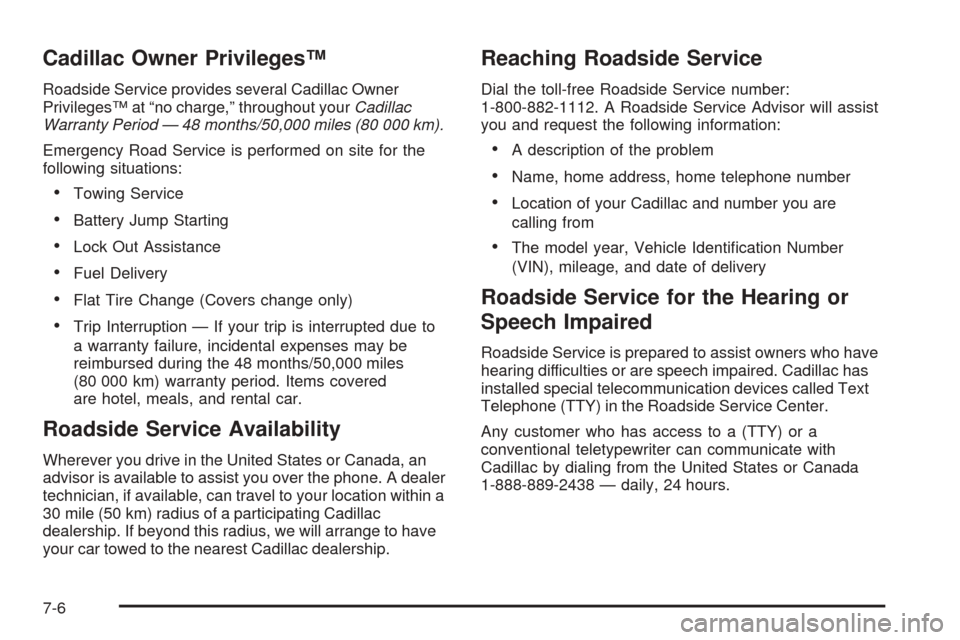
Cadillac Owner Privileges™
Roadside Service provides several Cadillac Owner
Privileges™ at “no charge,” throughout yourCadillac
Warranty Period — 48 months/50,000 miles (80 000 km).
Emergency Road Service is performed on site for the
following situations:
Towing Service
Battery Jump Starting
Lock Out Assistance
Fuel Delivery
Flat Tire Change (Covers change only)
Trip Interruption — If your trip is interrupted due to
a warranty failure, incidental expenses may be
reimbursed during the 48 months/50,000 miles
(80 000 km) warranty period. Items covered
are hotel, meals, and rental car.
Roadside Service Availability
Wherever you drive in the United States or Canada, an
advisor is available to assist you over the phone. A dealer
technician, if available, can travel to your location within a
30 mile (50 km) radius of a participating Cadillac
dealership. If beyond this radius, we will arrange to have
your car towed to the nearest Cadillac dealership.
Reaching Roadside Service
Dial the toll-free Roadside Service number:
1-800-882-1112. A Roadside Service Advisor will assist
you and request the following information:
A description of the problem
Name, home address, home telephone number
Location of your Cadillac and number you are
calling from
The model year, Vehicle Identi�cation Number
(VIN), mileage, and date of delivery
Roadside Service for the Hearing or
Speech Impaired
Roadside Service is prepared to assist owners who have
hearing difficulties or are speech impaired. Cadillac has
installed special telecommunication devices called Text
Telephone (TTY) in the Roadside Service Center.
Any customer who has access to a (TTY) or a
conventional teletypewriter can communicate with
Cadillac by dialing from the United States or Canada
1-888-889-2438 — daily, 24 hours.
7-6
Page 403 of 420

Vehicle Data Collection and Event
Data Recorders
Your vehicle, like other modern motor vehicles, has a
number of sophisticated computer systems that monitor
and control several aspects of the vehicle’s performance.
Your vehicle uses on-board vehicle computers to monitor
emission control components to optimize fuel economy,
to monitor conditions for airbag deployment and, if so
equipped, to provide anti-lock braking and to help the
driver control the vehicle in difficult driving situations.
Some information may be stored during regular
operations to facilitate repair of detected malfunctions;
other information is stored only in a crash event by
computer systems, such as those commonly called event
data recorders (EDR).In a crash event, computer systems, such as the Airbag
Sensing and Diagnostic Module (SDM) in your vehicle
may record information about the condition of the vehicle
and how it was operated, such as data related to
engine speed, brake application, throttle position, vehicle
speed, safety belt usage, airbag readiness, airbag
performance, and the severity of a collision. This
information has been used to improve vehicle crash
performance and may be used to improve crash
performance of future vehicles and driving safety. Unlike
the data recorders on many airplanes, these on-board
systems do not record sounds, such as conversation of
vehicle occupants.
To read this information, special equipment is needed
and access to the vehicle or the device that stores
the data is required. GM will not access information
about a crash event or share it with others other than:
with the consent of the vehicle owner or, if the
vehicle is leased, with the consent of the lessee,
in response to an official request of police or similar
government office,
as part of GM’s defense of litigation through the
discovery process, or
as required by law.
7-9
Page 411 of 420
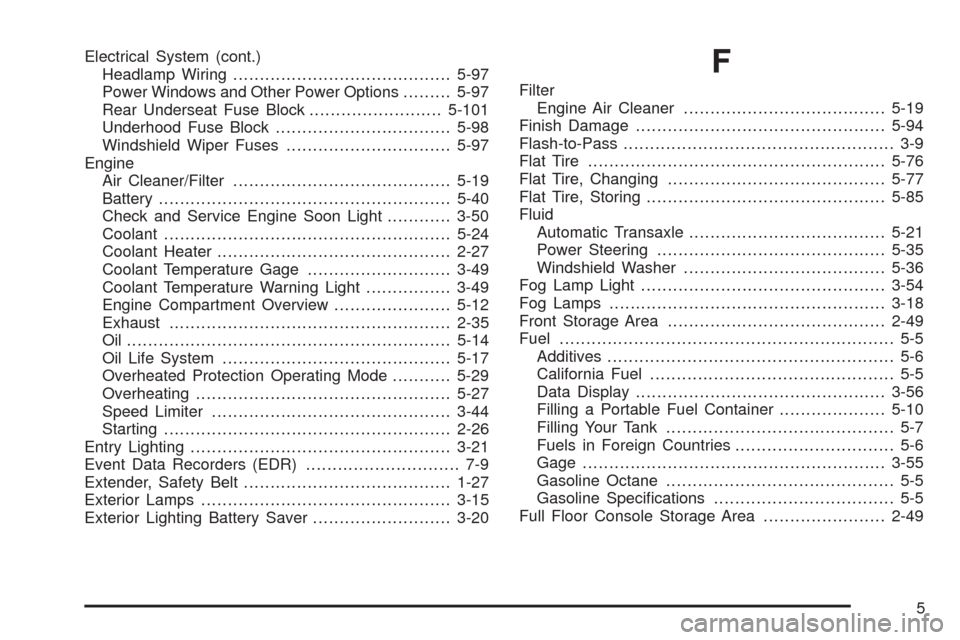
Electrical System (cont.)
Headlamp Wiring.........................................5-97
Power Windows and Other Power Options.........5-97
Rear Underseat Fuse Block.........................5-101
Underhood Fuse Block.................................5-98
Windshield Wiper Fuses...............................5-97
Engine
Air Cleaner/Filter.........................................5-19
Battery.......................................................5-40
Check and Service Engine Soon Light............3-50
Coolant......................................................5-24
Coolant Heater............................................2-27
Coolant Temperature Gage...........................3-49
Coolant Temperature Warning Light................3-49
Engine Compartment Overview......................5-12
Exhaust.....................................................2-35
Oil .............................................................5-14
Oil Life System...........................................5-17
Overheated Protection Operating Mode...........5-29
Overheating................................................5-27
Speed Limiter.............................................3-44
Starting......................................................2-26
Entry Lighting.................................................3-21
Event Data Recorders (EDR)............................. 7-9
Extender, Safety Belt.......................................1-27
Exterior Lamps...............................................3-15
Exterior Lighting Battery Saver..........................3-20F
Filter
Engine Air Cleaner......................................5-19
Finish Damage...............................................5-94
Flash-to-Pass................................................... 3-9
Flat Tire........................................................5-76
Flat Tire, Changing.........................................5-77
Flat Tire, Storing.............................................5-85
Fluid
Automatic Transaxle.....................................5-21
Power Steering...........................................5-35
Windshield Washer......................................5-36
Fog Lamp Light..............................................3-54
Fog Lamps....................................................3-18
Front Storage Area.........................................2-49
Fuel............................................................... 5-5
Additives...................................................... 5-6
California Fuel.............................................. 5-5
Data Display...............................................3-56
Filling a Portable Fuel Container....................5-10
Filling Your Tank........................................... 5-7
Fuels in Foreign Countries.............................. 5-6
Gage.........................................................3-55
Gasoline Octane........................................... 5-5
Gasoline Speci�cations.................................. 5-5
Full Floor Console Storage Area.......................2-49
5
Page 415 of 420

N
Navigation/Radio System, see Navigation
Manual......................................................3-99
New Vehicle Break-In......................................2-24
Night Vision System........................................3-22
Normal Maintenance Replacement Parts............6-13
O
Odometer......................................................3-43
Odometer, Trip...............................................3-43
Off-Road Recovery..........................................4-12
Oil
Engine.......................................................5-14
Life Indicator...............................................3-79
Pressure Light.............................................3-53
Oil, Engine Oil Life System..............................5-17
Older Children, Restraints................................1-28
Online Owner Center........................................ 7-3
OnStar
®System, see OnStar®Manual...............2-42
Other Warning Devices...................................... 3-6
Outlet Adjustment............................................3-34
Outside
Automatic Dimming Mirror.............................2-41
Convex Mirror.............................................2-41
Curb View Assist Mirror................................2-41
Heated Mirrors............................................2-41
Power Mirrors.............................................2-40Overheated Engine Protection
Operating Mode..........................................5-29
Owner Checks and Services.............................. 6-9
Owners, Canadian............................................... ii
P
Parade Dimming.............................................3-21
Park Aid........................................................3-26
Park (P)
Shifting Into................................................2-32
Shifting Out of............................................2-34
Parking
Assist........................................................3-26
Brake........................................................2-31
Brake Indicator Light....................................3-47
Over Things That Burn.................................2-35
Passenger Compartment Air Filter.....................3-36
Passing.........................................................4-13
PASS-Key
®III ................................................2-21
PASS-Key®III Operation..................................2-22
Performance Shifting.......................................2-31
Personalization, Climate Controls......................3-39
Power
Accessory Outlets........................................3-28
Door Locks.................................................2-10
Electrical System.........................................5-97
Inadvertent Battery Saver.............................3-22
9